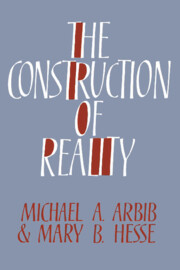Book contents
- Frontmatter
- Contents
- Preface
- Chapter 1 Posing the problem
- Chapter 2 The intelligence of the artificial
- Chapter 3 Schema theory
- Chapter 4 Relating mind and brain
- Chapter 5 Freedom
- Chapter 6 Freud on psychology and religion
- Chapter 7 Schemas: from the individual to the social
- Chapter 8 Language, metaphor, and a new epistemology
- Chapter 9 Interpretation and reality
- Chapter 10 Religions as social schemas
- Chapter 11 The Great Schema
- Chapter 12 Secular schemas
- References
- Author index
- Subject index
Chapter 12 - Secular schemas
Published online by Cambridge University Press: 22 September 2009
- Frontmatter
- Contents
- Preface
- Chapter 1 Posing the problem
- Chapter 2 The intelligence of the artificial
- Chapter 3 Schema theory
- Chapter 4 Relating mind and brain
- Chapter 5 Freedom
- Chapter 6 Freud on psychology and religion
- Chapter 7 Schemas: from the individual to the social
- Chapter 8 Language, metaphor, and a new epistemology
- Chapter 9 Interpretation and reality
- Chapter 10 Religions as social schemas
- Chapter 11 The Great Schema
- Chapter 12 Secular schemas
- References
- Author index
- Subject index
Summary
We have presented schemas as embodying a constructed reality that is always open to further adaptation, explaining why there must be a plurality of view-points, yet also offering mechanisms for reflective critique and self-correction that protect us from an uncritical relativism. In the previous chapter, we considered the “Great Schema,” a reading of the Bible that views the God reality of which it is the schema as immutable, whereas the hermeneutic process adapts our understanding of this fixed reality to changing human conditions.
This concluding chapter presents the case for a different view: seeing secular schemas as a reading of the human condition as lying wholly within the spatiotemporal realm, with no appeal to God or to a “voluntarist” free will. Such schemas could be in flux yet maintain their ability to embody a multilevel reality encompassing persons and society as well as things. We show how ethics and human values might evolve without being grounded in a fixed God reality but rather in the critical development of a pluralist world view. First, we stress the extent to which our schema-based epistemology provides a schema that can be adapted by religious and secularist alike and that provides a measure of agreement despite dramatic disagreements about the ultimate constitution of Reality.
A measure of agreement
The last page of the New Testament offers the following stern warning of the sacredness of its text:
I warn every one who hears the words of the prophecy of this book: if any one adds to them, God will add to him the plagues described in this book, and if any one takes away from the words of the book of this prophecy, God will take away his share in the tree of life and in the holy city, which are described in this book.
(Rev. 22:18-19)- Type
- Chapter
- Information
- The Construction of Reality , pp. 244 - 267Publisher: Cambridge University PressPrint publication year: 1986



